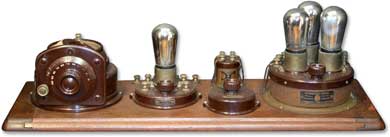| Contact |
| Back | Next | Home |
Atwater
Kent
Breadboard Receivers
|
|
|
The Model 3925 (also known as the Model 1) was introduced late in 1922 and consisted of a tuner, detector, and 1 stage amplifier. In order to avoid payment of patent fees for use of a regenerative circuit the unit was sold without the middle variometer installed. Kent sold the variometer as a separate item (frequently in the same advertisement as the radio, although its real function was never mentioned) and when installed by the user it provided additional RF signal boost through regeneration. To see an example of an Atwater Kent breadboard ad with the variometer sold as a separate item, click here. |
|
Kent offered an additional stage of audio amplification
with the 3-tube Model 3945 (also known as the Model 2.) It was shipped
about the same time as the Model 1. |
|
In the Model 3955, Atwater Kent's designers separated the detector tube in order to produce a clearer signal, free of interference from the audio amplifier. |
|
This version of the 3955 includes an RF amplification stage instead of a variometer. This improved sensitivity without making the set regenerative. |
|
|
|
In order to increase sensitivity, Atwater Kent added an RF amplifier to the existing "Open Receiving Set Model 3945" to create the Model 6. |
|
Introduced in early 1923, the 4066 added another stage of RF amplification, eliminating the need for a regenerative circuit. |
|
About 9 months later the Model 5 appeared. Virtually identical electrically to the 4066, it is one of the first examples of a "compact" design. Unfortunately the unit didn't perform well and was discontinued. The Atwater Kent Model 5 is quite rare and is highly prized by vintage radio collectors. |
|
The Model 9 was introduced shortly after the Model 5, returning to a single stage of RF amplification, but with a second variometer. |
|
|
|
The Model 4445 is a version of the Model 9 using terminal posts instead of a battery cable . |
|
The Radiodyne was introduced in the fall of 1923, employed two stages of RF amplification and was the first successful AK radio employing condenser tuning (The Model 8, introduced at the same time as the Model 5 also used a single tuning condenser, but it did not sell well). The Radiodyne was built in order to capitalize on the popularity of the new 3-dial, 5-tube TRF Neutrodyne radios such as the FADA 160 and Freed Eisemann NR-5. Unfortunately the "Radiodyne" trademark was already held by Western Coil, so Atwater Kent was forced to discontinue the unit. The Radiodyne is distinguished by its green tuning condenser cans and the "Radiodyne" label on the transformer tops. |
|
The Model 10A was introduced to replace the Radiodyne. It can be distinguished from the other Model 10's by its vertical RFcoils, the presence of a separate potentiometer located between the first and second stage, and the lack of a switch on the first RF coil. |
|
The Model 10B is recognized by the orthogonal (sideways mount) RF coils, the presence of a separate potentiometer located between the first and second stage, and the presence of a switch on the first RF coil. |
|
|
|
The 10C also has orthogonal (sideways mount) RF coils, but the separate potentiometer has been removed. and the board is somewhat shorter.
|
|
In early 1924 Atwater Kent added an additional stage of amplification to the Model 10 to create the 6-tube Model 12, the last of the "breadboard" line (well, almost the last. About the same time they also shipped the 9C, essentially the same set as the Model 9 but with condensers in place of the variometers.)
Note: For an in-depth look at Atwater Kent and many other radio manufacturers of the 1920's, see "Radio Manufacturers of the 1920's" by Alan Douglas. This great three volume set can be purchased online through Antique Radio Classified. |
| Contact |
| Back | Next | Home |

